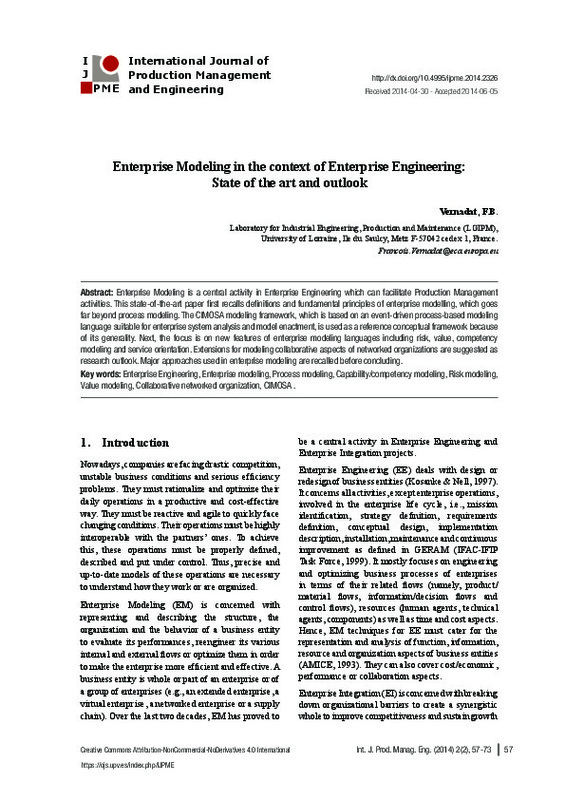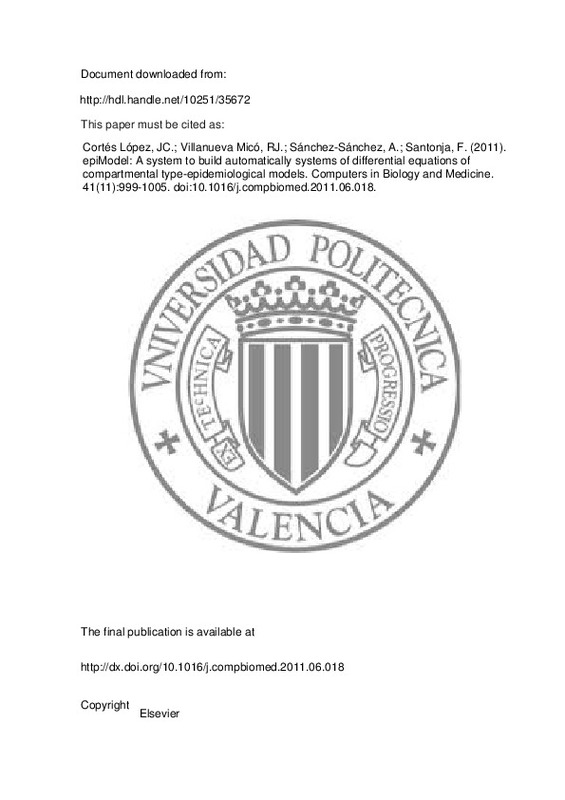JavaScript is disabled for your browser. Some features of this site may not work without it.
Buscar en RiuNet
Listar
Mi cuenta
Estadísticas
Ayuda RiuNet
Admin. UPV
Enterprise Modeling in the context of Enterprise Engineering: State of the art and outlook
Mostrar el registro sencillo del ítem
Ficheros en el ítem
| dc.contributor.author | Vernadat, François
|
es_ES |
| dc.date.accessioned | 2015-05-18T10:20:55Z | |
| dc.date.available | 2015-05-18T10:20:55Z | |
| dc.date.issued | 2014-07-11 | |
| dc.identifier.issn | 2340-5317 | |
| dc.identifier.uri | http://hdl.handle.net/10251/50383 | |
| dc.description.abstract | [EN] Enterprise Modeling is a central activity in Enterprise Engineering and can facilitate Production Management activities. This state-of-the-art paper first recalls definitions and fundamental principles of enterprise modelling, which goes far beyond process modeling. The CIMOSA modeling framework, which is based on an event-driven process-based modeling language suitable for enterprise system analysis and model enactment, is used as a reference conceptual framework because of its generality. Next, the focus is on new features of enterprise modeling languages including risk, value, competency modeling and service orientation. Extensions for modeling collaborative aspects of networked organizations are suggested as research outlook. Major approaches used in enterprise modeling are recalled before concluding. | es_ES |
| dc.language | Inglés | es_ES |
| dc.publisher | Editorial Universitat Politècnica de València | |
| dc.relation.ispartof | International Journal of Production Management and Engineering | |
| dc.rights | Reconocimiento - No comercial - Sin obra derivada (by-nc-nd) | es_ES |
| dc.subject | Enterprise Engineering | es_ES |
| dc.subject | Enterprise modeling | es_ES |
| dc.subject | Process modeling | es_ES |
| dc.subject | Capability/competency modeling | es_ES |
| dc.subject | Risk modeling | es_ES |
| dc.subject | Value modeling | es_ES |
| dc.subject | Collaborative networked organization | es_ES |
| dc.subject | CIMOSA | es_ES |
| dc.title | Enterprise Modeling in the context of Enterprise Engineering: State of the art and outlook | es_ES |
| dc.type | Artículo | es_ES |
| dc.date.updated | 2015-05-18T10:12:54Z | |
| dc.identifier.doi | 10.4995/ijpme.2014.2326 | |
| dc.rights.accessRights | Abierto | es_ES |
| dc.description.bibliographicCitation | Vernadat, F. (2014). Enterprise Modeling in the context of Enterprise Engineering: State of the art and outlook. International Journal of Production Management and Engineering. 2(2):57-73. https://doi.org/10.4995/ijpme.2014.2326 | es_ES |
| dc.description.accrualMethod | SWORD | es_ES |
| dc.relation.publisherversion | https://doi.org/10.4995/ijpme.2014.2326 | es_ES |
| dc.description.upvformatpinicio | 57 | es_ES |
| dc.description.upvformatpfin | 73 | es_ES |
| dc.type.version | info:eu-repo/semantics/publishedVersion | es_ES |
| dc.description.volume | 2 | |
| dc.description.issue | 2 | |
| dc.identifier.eissn | 2340-4876 | |
| dc.description.references | AMICE. (1993). CIMOSA: Open System Architecture for CIM, 2nd revised and extended edition. Berlin: Springer-Verlag. 234 pages. | es_ES |
| dc.description.references | Camarinha-Matos, L. M., & Afsarmanesh, H. (2007). A comprehensive modeling framework for collaborative networked organizations. Journal of Intelligent Manufacturing, 18(5), 529-542. doi:10.1007/s10845-007-0063-3 | es_ES |
| dc.description.references | Camarinha-Matos, L. M., Afsarmanesh, H., Galeano, N., & Molina, A. (2009). Collaborative networked organizations – Concepts and practice in manufacturing enterprises. Computers & Industrial Engineering, 57(1), 46-60. doi:10.1016/j.cie.2008.11.024 | es_ES |
| dc.description.references | Chakravarthy, S. (1989). Rule management and evaluation: an active DBMS perspective. ACM SIGMOD Record, 18(3), 20-28. doi:10.1145/71031.71034 | es_ES |
| dc.description.references | Chen, H. (2010). Editorial. ACM Transactions on Management Information Systems, 1(1), 1-5. doi:10.1145/1877725.1877726 | es_ES |
| dc.description.references | Clivillé, V., Berrah, L., & Mauris, G. (2007). Quantitative expression and aggregation of performance measurements based on the MACBETH multi-criteria method. International Journal of Production Economics, 105(1), 171-189. doi:10.1016/j.ijpe.2006.03.002 | es_ES |
| dc.description.references | Curtis, B., Kellner, M. I., & Over, J. (1992). Process modeling. Communications of the ACM, 35(9), 75-90. doi:10.1145/130994.130998 | es_ES |
| dc.description.references | Dalal, N. P., Kamath, M., Kolarik, W. J., & Sivaraman, E. (2004). Toward an integrated framework for modeling enterprise processes. Communications of the ACM, 47(3), 83-87. doi:10.1145/971617.971620 | es_ES |
| dc.description.references | Doumeingts, G., & Vallespir, B. (1995). A methodology supporting design and implementation of CIM systems including economic evaluation. In P. Brandimarte & A. Villa, Eds. Optimization Models and Concepts in Produc-tion Management (pp. 307-331). New-York, NY: Gordon and Breach Science Publishers. | es_ES |
| dc.description.references | Doumeingts, G., & Ducq, Y. (2001). Enterprise modelling techniques to improve efficiency of enterprises. Production Planning & Control, 12(2), 146-163. doi:10.1080/09537280150501257 | es_ES |
| dc.description.references | Harzallah, M., Berio, G., & Vernadat, F. (2006). Analysis and modeling of individual competencies: toward better management of human resources. IEEE Transactions on Systems, Man, and Cybernetics - Part A: Systems and Humans, 36(1), 187-207. doi:10.1109/tsmca.2005.859093 | es_ES |
| dc.description.references | Jagdev, H. S., & Thoben, K.-D. (2001). Anatomy of enterprise collaborations. Production Planning & Control, 12(5), 437-451. doi:10.1080/09537280110042675 | es_ES |
| dc.description.references | JORYSZ, H. R., & VERNADAT, F. B. (1990). CIM-OSA Part 1: total enterprise modelling and function view. International Journal of Computer Integrated Manufacturing, 3(3-4), 144-156. doi:10.1080/09511929008944444 | es_ES |
| dc.description.references | Khalaf, R., Curbera, F., Nagy, W.A., Mukhi, N., Tai, S., & Duftler, M. (2005). Understanding Web Services. In M. Singh, Ed. Practical Handbook of Internet Computing (Chap. 27). Boca Raton, FL: Chapman & Hall/CRC Press. | es_ES |
| dc.description.references | Kosanke, K., & Nell, J. G. (Eds.). (1997). Enterprise Engineering and Integration. doi:10.1007/978-3-642-60889-6 | es_ES |
| dc.description.references | Kosanke, K., Vernadat, F.B., & Zelm, M. (2014). Means to enable Enterprise Interoperation: CIMOSA Object Capa-bility Profiles and CIMOSA Collaboration View, Proc. of the 19th World Congress of the IFAC, Cape Town, South Africa, 24-19 August 2014. | es_ES |
| dc.description.references | Larson, N., & Kusiak, A. (1996). Managing design processes: a risk assessment approach. IEEE Transactions on Systems, Man, and Cybernetics - Part A: Systems and Humans, 26(6), 749-759. doi:10.1109/3468.541335 | es_ES |
| dc.description.references | Li, Q., Wang, Z., Li, W., Li, J., Wang, C., & Du, R. (2013). Applications integration in a hybrid cloud computing environment: modelling and platform. Enterprise Information Systems, 7(3), 237-271. doi:10.1080/17517575.2012.677479 | es_ES |
| dc.description.references | Owen, S., & Walker, Z. (2013). Enterprise Modelling and Architecture. New Dehli, India: Ocean Media Pvt. Ltd. | es_ES |
| dc.description.references | Roboam, M., Zanettin, M., & Pun, L. (1989). GRAI-IDEF0-Merise (GIM): Integrated methodology to analyse and design manufacturing systems. Computer Integrated Manufacturing Systems, 2(2), 82-98. doi:10.1016/0951-5240(89)90021-9 | es_ES |
| dc.description.references | Ross, D. T., & Schoman, K. E. (1977). Structured Analysis for Requirements Definition. IEEE Transactions on Software Engineering, SE-3(1), 6-15. doi:10.1109/tse.1977.229899 | es_ES |
| dc.description.references | Shah, L.A., Etienne, A., Siadat, A., & Vernadat, F. (2014). Decision-making in the manufacturing environment using a value-risk graph. Journal of Intelligent Manufacturing, 25, 2. | es_ES |
| dc.description.references | Scheer, A.-W. (1992). Architecture of Integrated Information Systems. doi:10.1007/978-3-642-97389-5 | es_ES |
| dc.description.references | Scheer, A.-W. (1999). ARIS — Business Process Modeling. doi:10.1007/978-3-642-97998-9 | es_ES |
| dc.description.references | Vernadat, F.B. (1996). Enterprise Modeling and Integration: Principles and Applications. London: Chapman & Hall. 528 pages. | es_ES |
| dc.description.references | Vernadat, F. B. (2007). Interoperable enterprise systems: Principles, concepts, and methods. Annual Reviews in Control, 31(1), 137-145. doi:10.1016/j.arcontrol.2007.03.004 | es_ES |










